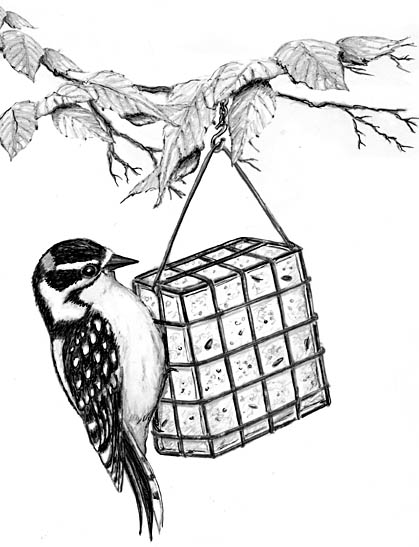
Dear Bird Folks,
I’ve been fortunate to have a Downy Woodpecker family coming to the feeders in my backyard. The parents pick off bits of suet and then stuff them into the waiting mouths of their begging babies. Seeing those accepting little birds makes me wonder if the food I’m putting out is safe. Does suet spoil in the summer heat? Could I be doing the woodpeckers more harm than good?
– Stephanie. Harwich, MA
Good for you, Steph,
I’m glad you are less concerned about your entertainment and more concerned about the birds’ health. You would think that everyone who fed birds would be equally concerned, but that’s not always the case. Nearly every week some well-dressed person brings me in a feeder while complaining that “the birds won’t come to it.” You should see these disgusting things, all dirty and filled with moldy, rotten seed. It’s no wonder birds avoid their feeders. I have to put on a hazmat suit just to get near them (the feeders, not the people).
By attracting birds to your yard you are essentially inviting guests over for dinner. I know that last line sounds a bit like Martha Stewart, and it should. I totally stole it from her website. Don’t ask me why I was looking at Martha’s website. Okay, fine, I’ll tell you. My dog was having a few friends over and I was looking for a recipe to make a Milk-Bone centerpiece. I knew she’d have it, but that bird line was a bonus. Good old Martha even knows about bird etiquette, too. She can do it all.
In the old days, back when winters were actually cold, bird feeding was a seasonal activity. Some of us felt bad for the shivering birds and would occasionally toss out a few crusts of bread or put out leftover gobs of bacon fat. Others would fill homemade feeders with the dreaded wild bird mix seed. When the snow went away, the feeders, the fat and the crusts of bread also went away. In recent years, for whatever reason, probably because TV stinks, bird feeding has become a year-round activity. (Thank goodness for that.) Homemade feeders were eventually replaced with slick factory produced feeders. Sunflower seed replaced that awful mixed seed and bacon fat was replaced with packaged suet. The golden age of bird feeding was about to begin. I get choked up just thinking about it.
At first, the suet companies missed the boat. They were stuck in the old winter-only bird feeding ruts of years passed. The suet that they made melted easily and couldn’t be used in warm weather. The birds lost out on having suet in the summer and people, like me, lost out on billions in sales. Then, some genius with a degree in suetology, discovered that if meal and grain were added to the suet it wouldn’t melt as easily. Year-round suet was born. Today we sell even more suet in the summer than we do in the winter. Sweet!
Year-round suet feeding may be okay to do, but a bit of common sense has to be used or you’ll be no better than those well-dressed slobs I mentioned in the first paragraph. To begin with, never use raw, meat market suet in the summer. Raw suet will quickly turn rancid with the heat. Hanging rancid suet out in your yard is not only bad for birds, but it will probably hurt the chances of your home being on this year’s garden tour. In the summer only use packaged suet that states that it’s for “year-round use” or that it’s “no melt.” And only use it in the shade. If melted or dripping suet gets onto a bird’s feathers, there could be big trouble. Suet isn’t toxic, like the stuff that poured out of the Exxon Valdez, but the results could be the same if it were to drip onto a bird. Greasy feathers lose their ability to protect birds from the elements and that’s bad. The slick look might have worked well for the young Elvis, but it’s never a good look for woodpeckers, no matter how well they shake their hips.
The suet companies did a good thing by producing year-round suet, but then they got silly. Not content with offering what the birds needed, they started loading the shelves with products that had more to do with appealing to humans than feeding birds. Soon suet began to be flavored with such foolish things as oranges, apples, cherries, and papayas. Yes, papayas. Suddenly a suet display looked and smelled more like the afternoon buffet on a Caribbean cruise ship. To be fair, I’ve never used the exotic flavors myself, but a customer said that she has tried and tested them all. So I asked her which suet her birds preferred. Her reply was: “It doesn’t make a damn bit of difference. They eat them all just as fast.” Just as I suspected.
I’m glad you are concerned about your baby woodpeckers, Stephanie. What you are doing is fine, as long as you use rendered, year round-suet with simple ingredients. Also, try to keep your suet in the shade and be sure to take it down if it starts to get drippy. If you don’t follow those precautions, both the birds and Martha Stewart will be upset with you. And that could ruin your chance of ever getting the recipe for a Milk-Bone centerpiece.